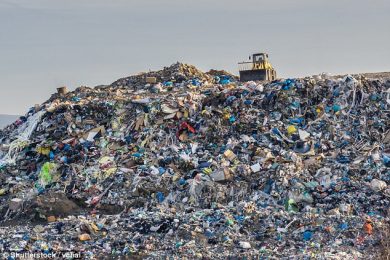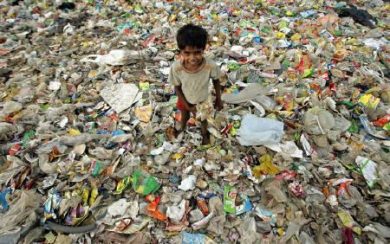
The Plastic Epidemic
Spend an afternoon at a Thai market and you’ll end the day with a larger carbon footprint than you started with. This is most likely thanks to plastic – a cheap and accessible favourite of Thailand that now suffocates its beaches and marine life. A recent study found Thailand to be one of the top six sources of marine plastic; together with the other five countries, all of which are in Asia, Thailand contributes to 60% of plastic pollution at sea and it’s not difficult to understand why. Buy a couple of t-shirts at the market and you can bet they’ll be bagged.
A styrofoam container for fried rice, along with plastic utensils, will also be put in a plastic bag. Order iced coffee and the amount of plastic waste is considerable: cup, lid, straw, and, in most cases, a little bag to keep condensation off your fingers. Soda might be put directly into a plastic bag, with a few straws incase one is for some reason not enough. Most people consume plastic in their daily lives, and few consider the impact this deeply unsustainable product is having on our planet.

Every year, the world produces 300 million tonnes of plastic – enough to circle the earth four times. Of this amount, half is composed of single-use items like those described above: plastic bags, cups, straws and cutlery. We use these items once for the sake of convenience and throw them away immediately afterwards. Most hard plastics such as cups should be recyclable, but they aren’t always disposed of properly; meanwhile, soft plastics like single-use bags go right into a landfill – or worse, into the ocean.
Eight million tonnes of waste are dumped into our oceans each year, equalling one truckload per minute. Even more shocking than the amount of waste we produce is the fact that plastic, the majority of our trash, takes 500 to 1,000 years to decompose. In the past ten years we have used more plastic than in the entirety of the last century, and virtually every piece of plastic that has ever been produced still exists on earth in some form, excluding the small percentage that has been incinerated. It is therefore unsurprising that our poor planet – along with its wildlife – isn’t able to keep up with the unsustainable choices we have started to make in the past few decades.

Human-made waste now covers a jaw-dropping 40% of ocean surfaces, and 90% of this waste is made up of plastic. Off the coast of California, a floating mass of trash known as the Great Pacific Garbage Patch is the largest garbage patch in the world at twice the size of Texas. Here, plastic pieces outnumber sea life six to one.
It is estimated that one million seabirds and 100,000 marine animals are killed annually by plastic. Disturbing images of these creatures, cut open to reveal stomachs full of plastic, have sparked discussion across the world. Some of the most powerful stories are those about whales washed ashore with their stomachs bloated with plastic pieces. Recently, the death of a short-finned pilot whale in Thailand’s Songkhla province spurred fears for marine life. Eighty plastic bags, weighing about 8kg, were found in its stomach.
People sometimes assume that marine animals consume plastic simply because they’re dumb and eat anything, but the truth is plastic seeps into the diets of even the smartest and most accomplished hunters. In fact, it has found its way into 180 species of marine animals. In an interview about Blue Planet II, David Attenborough describes a sequence about a mother albatross who returns after a long, calculated hunting journey to feed her young; what emerges from her mouth? Plastic.

To many of these animals, plastic looks, smells, feels, and even sounds like food. In some cases, algae growing on pieces of plastic are consumed by krill. The feast releases a chemical that draws marine animals, but they are attracted to the plastic instead of the krill they came for. In other cases, items such as plastic bags are mistaken for jellyfish, which would explain why jellyfish-eating turtles are so often entangled in them. In still other cases, echolocation tricks toothed whales and dolphins into thinking pieces of plastic are edible, because they sound just like food. The animals consume the trash we produce, or are physically trapped by it.
These statistics are extremely disheartening, but hope is not totally lost. As more and more statistics and images surface depicting animals ensnared in beer six-pack holders and plastic bags, more people are talking about how to stop the plastic epidemic. Countries across the globe have made efforts to decrease the amount of plastic pouring into our oceans. Earlier this year, Taiwan made one of the boldest bans on plastic worldwide when it announced that all single-use plastics are to be phased out by 2030. Britain also pledged to eradicate avoidable plastic waste by 2042, including straws, drink stirrers and cotton buds. Not long afterwards, the EU proposed a similar ban on these disposable products. The EU ban will target the ten plastics most commonly found in oceans, and EU member states will be responsible for meeting targets to reduce single-use plastics.
There are some success stories for these types of bans. After South Africa introduced a plastic bag ban in 2003, the use of plastic bags decreased by 90 percent (although illegal use of the product has increased gradually since then). In China, a 2008 ban on thin plastic bags led to a reported two-thirds reduction in plastic bag use. Countries in Europe in particular have been active in their attempts to eliminate plastic bags. As early as 1994, Denmark began charging a tax on plastic bags, which caused their usage to decrease by half, from 800 million bags per year to 400 million.

These success stories tell us that if governments recognise the deplorable trash-ridden conditions of our oceans, and create laws to ban harmful plastic products, we may be able to clean up our planet. Hopefully Thailand, one of the sea’s top polluters, follows the anti-plastic trend and takes initiative to make its beaches beautiful again. Perhaps Thailand has already begun the shift toward a greener world. Just last month, the Pollution Control Department set a target to eradicate plastic seals on water bottles, which are responsible for 520 tonnes of annual waste. Even more exciting is a development from World Environment Day on June 6, when more than 20 Thai businesses and state agencies signed a memorandum of understanding to cut plastic waste in half by 2027.
There are also steps you can take to reduce your carbon footprint. Plastic is deeply rooted in modern society, but there are always measure individuals can take to reduce their plastic consumption. Going shopping? Always remember to bring a reusable bag (or many!), and turn down every plastic bag that is offered to you, no matter how small. Getting coffee? Bring a thermos or mason jar, and your own stainless steel straw (readily available on Amazon or in stores). Lunch on-the-go? Offer your reusable container to the people at the counter, and bring utensils from home. By doing these simple things, you’ve managed to avoid disposable plastic bags, cups, lids, straws, utensils and containers. These practices are generally minimal and easy to implement, and with them, we could decrease the amount of waste in our ocean by an incredible amount – and marine animals would thank us for it.



